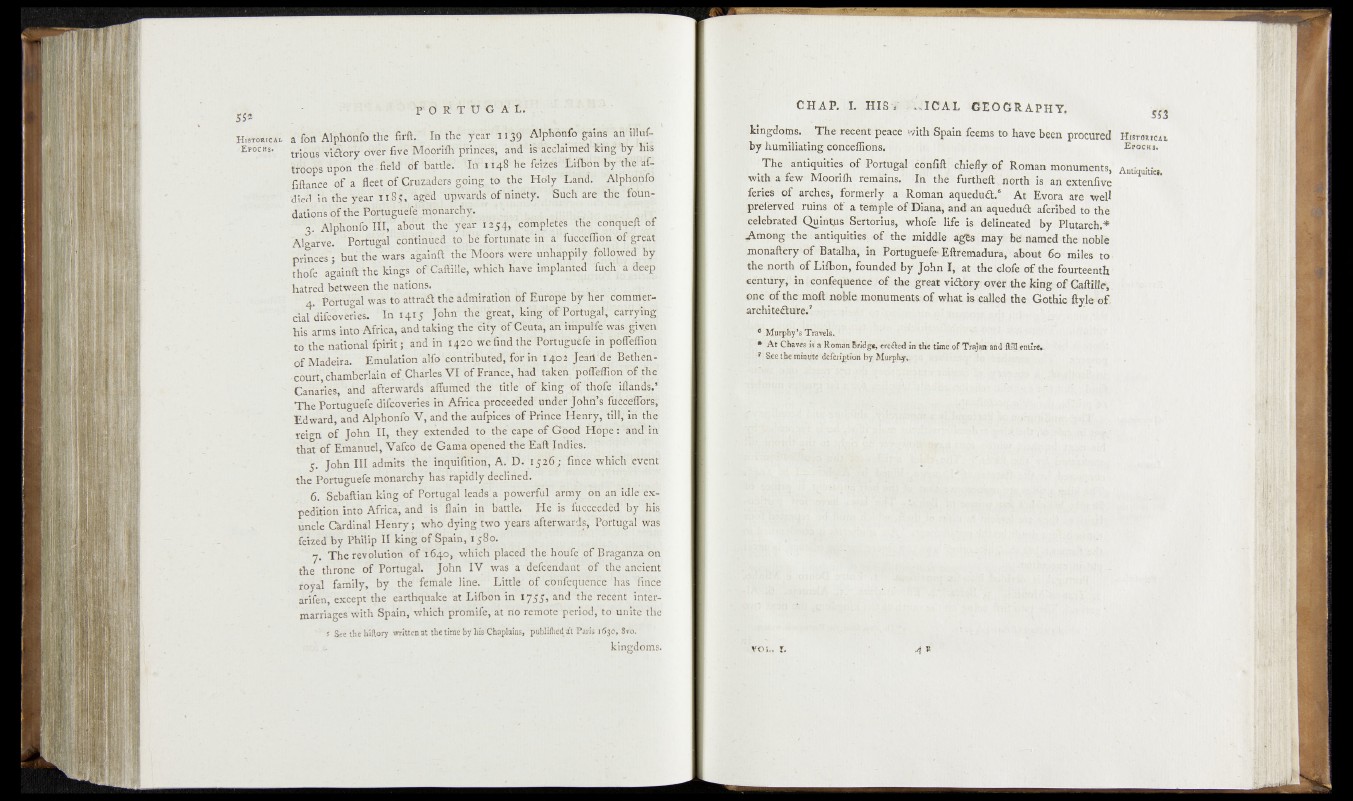
F O R T U G A L.
H istorical
'E pochs.
a fon Alphonfo th e K f t h e 'y e a f -I i‘| 9
trio as v id o ry o lc r five M o o rifh 'princes, a n d • iFacclairoed k in g ‘b y his
ftyo^'s dp o n th e - f id d y f% t l e . \ M 4 r 4t :«e
fiftance o f a fleet p f ^ r u z ^ r s going, to t]ie H o ly Land. 'Xlp&mfd
died, in the year 1185, agVd upwards o f ninety. Such are the 'fq h n -
dafiqns'dV'the j*!-; ‘-p '-'U ^V r U r j .;{jV
' 0. Alphonfo lilj aboift the1 ye ir 1254, completes the co&mjytj)T
Algarv e. Porfugid'continued to.be fortunatem a‘ fucpeffiorripf great
princes" ; but the wars againft the “Moors were unhappily followed; b y
thofb againfe the Engs which IiaTCri^linfed^Igdv
hatred between the nations. . n - t -
4. P b r td ^ d was to a t t r a d th e admiration b f Europe b y h e r.co tn irie r-
c ia ld if c b vm e i In 1415 Jb h n the great, king'bFTortugal,1-^rVyfng
his arms into-Africa, and taking the c ity o f Ceuta, a h iihpulfe was- giyeh
to th e national f p i r i t a n d in 14*20 we find th fF o riu g u g fe ‘ih poffeflion
o f M adeira. Emulation alfo'contributed, for in ‘^402 Jea il'd e Bethen-
court, chamberlain o f Charles V I o f France, had taken poffeflion''of th e “
Canaries, and afterwards aflumed th e title o f h i h g ^ t f i ^ / p a n d s /
T h e Portuguefe difcoveries in Africa proceeded under Jo h n ’s fucce'ffofs;
Edward, and Alphonfo V , and the aufpices o f Prince H e n ry , till; iri the
reigtt ©f Jo h n II , th ey extended to the cape o f Good H o p e r"’ahdlih
th a t o f Emanuel, Vafco de Gama opened th e Eaft Indies!' ••
5. Jo h n I I I admits th e inquifitioh, A. D.’VyicT; Triage whicli^eVetit''
the Portuguefe monarchy h a s ’rapidly declined.
6. Sebaftian kihg o f Portugal leads a powerful arniy o n an id le ^ ejc -
pediiion into Africa, and is flain in battle! H e is W e e d e d 'b y Hi§
uncle Cardinal H e n r y ; who d ying "two years afterwar ds,^Ppftugal‘ was
fek ed by Philip I I k in g .o f Spain, 1 5 8 0 / ,
n . T h e revolution o f i 640, which placed th e houfi;' o f Braganza o n
the th ro n e o f Portugal. Jo h n IV was ’a
royal family, by th e female line. L ittle ' o f T&fe '^ H e -
arifen, except th e earthquake at Lifbon in 1755, and th e recent intermarriages
with Spain, which promife, a t no remote period, to unite the
" 1 S.ee the hittory written at the time by his Chaplains, publiflied at Paris i^ o .S v o .
u. p .. . ' ' . • • ' kingdoms.
CH A P . I. HIS 1 .« I C A L G E O G R A PH Y . M
kingdoms. The recent peace with Spain feems to have been procured Historical
by humiliating concefiions. I- E fochs.
The antiquities^ of Portugal eqpfift, chiefly of Roman monuments, Antmitk*
with a few Moorifh. remains.1 In the' furtheft .'north is an extenfive
feries of arches, formerly a<> Roman aqueduct;“ At Evora are well
preferved ruins of a tempfe~of Diana, and an aquedud aferibed to the
celebrated Quintals Sertorius, whofe life is delineated by Plutarch.*
A^mong the antiquities, of the middle ages may be named the noble
monaftery of Batalba, m Portuguefe* Eftremadura, about 60 miles to .
the north of Lifbon, founded by John I, at theiclofe of the fourteenth
century, in confeqhence of the great vidory-over the king of Caftille,
pne ofthe mofl: noHe moaumeats of what called the Gothic ftyle e f
architeduire.7
* Murpliy’ s Travels... •
V ^ Cl®™pa RomanBridge, ere&ed in the time of Trajan and SOI entire..
^ See,t]^.miniife dtfin'fcdosi by ;
4 B